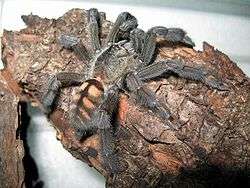Venezuelan suntiger
| Venezuelan suntiger | |
|---|---|
 | |
| Venezuelan Suntiger | |
| Scientific classification | |
| Kingdom: | Animalia |
| Phylum: | Arthropoda |
| Class: | Arachnida |
| Order: | Araneae |
| Family: | Theraphosidae |
| Genus: | Psalmopoeus |
| Species: | P. irminia Saager, 1994 |
The Venezuelan suntiger (Psalmopoeus irminia) is a striking tarantula species from Venezuela and hence considered a New World species. It has hairy legs which are typically dark in color (predominantly black) with a black carapace. They do not possess urticating hairs, which is rare for a new world tarantula species. Males are generally slightly lighter and more faded in color than females. Females are strikingly colored with bright orange chevrons on their long legs and a tiger stripe design on their abdomens. It is a large species, regularly reaching lengths of 6 inches. It has a medium growth rate and is an arboreal (tree dwelling) species.
It has a semi aggressive temperament (very few tarantulas are fully aggressive as most will rather run away than fight or bite) and is quite skittish and unpredictable with considerable speed when it rushes. It is unable to keep up these high speeds for long. It is not recommended to handle this species because of its disposition and also due to the venom and the likelihood of multiple bites. The venom of the P. irminia is quite potent and symptoms of envenomation may include full body aches and lightheadedness. However, it is important to note that like all other tarantula species, the venom cannot kill you. If given a choice, it would rather flee.[1] This species is not recommended for inexperienced owners, though other arboreal tarantula species can be more aggressive than the Venezuelan suntiger.
It thrives with temperatures of 80/85 °F with 75/80% humidity levels. Being an arboreal species, it requires a tall enclosure. Height is more important than floor space, and often the spider will make use of something to allow it to climb, such as cork bark. It will only require about 2 inches of substrate. It has a tendency to web up the enclosure.[2]